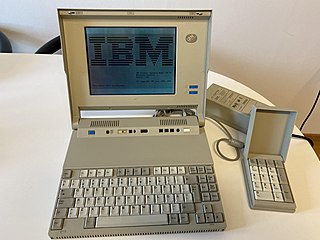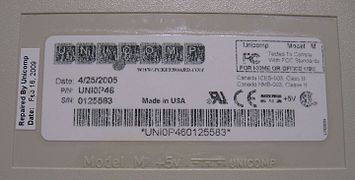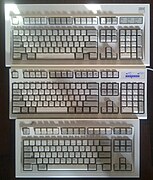The keyboard for IBM PC-compatible computers is standardized. However, during the more than 30 years of PC architecture being frequently updated, many keyboard layout variations have been developed.

The technology of computer keyboards includes many elements. Many different keyboard technologies have been developed for consumer demands and optimized for industrial applications. The standard full-size (100%) computer alphanumeric keyboard typically uses 101 to 105 keys; keyboards integrated in laptop computers are typically less comprehensive.

A trackball is a pointing device consisting of a ball held by a socket containing sensors to detect a rotation of the ball about two axes—like an upside-down ball mouse with an exposed protruding ball. Users roll the ball to position the on-screen pointer, using their thumb, fingers, or the palm of the hand, while using the fingertips to press the buttons.

In computing, a Control keyCtrl is a modifier key which, when pressed in conjunction with another key, performs a special operation. Similarly to the Shift key, the Control key rarely performs any function when pressed by itself. The Control key is located on or near the bottom left side of most keyboards, with many featuring an additional one at the bottom right.

A pointing stick is a small analog stick used as a pointing device typically mounted centrally in a computer keyboard. Like other pointing devices such as mice, touchpads or trackballs, operating system software translates manipulation of the device into movements of the pointer on the computer screen. Unlike other pointing devices, it reacts to sustained force or strain rather than to gross movement, so it is called an "isometric" pointing device. IBM introduced it commercially in 1992 on the ThinkPad 700 series under the name "TrackPoint", and patented an improved version of it in 1997. It has been used for business laptops, such as Acer's TravelMate, Dell's Latitude, HP's EliteBook and Lenovo's ThinkPad.

A touchpad or trackpad is a type of pointing device. Its largest component is a tactile sensor: an electronic device with a flat surface, that detects the motion and position of a user's fingers, and translates them to 2D motion, to control a pointer in a graphical user interface on a computer screen. Touchpads are common on laptop computers, contrasted with desktop computers, where mice are more prevalent. Trackpads are sometimes used with desktop setups where desk space is scarce. Wireless touchpads are also available, as detached accessories. Due to the ability of trackpads to be made small, they were additionally used on personal digital assistants (PDAs) and some portable media players.
The Model F was a series of computer keyboards produced mainly from 1981–1985 and in reduced volume until 1994 by IBM and later Lexmark. Its mechanical-key design consisted of a buckling spring over a capacitive PCB, similar to the later Model M keyboard that used a membrane in place of the PCB.

Model Mkeyboards are a group of computer keyboards designed and manufactured by IBM starting in 1985, and later by Lexmark International, Maxi Switch, and Unicomp. The keyboard's different variations have their own distinct characteristics, with the vast majority having a buckling-spring key design and uniform profile, swappable keycaps. Model M keyboards are notable among computer enthusiasts and frequent typists due to their durability, typing-feel consistency, and their tactile and auditory feedback.

Lexmark International, Inc. is a privately held American company that manufactures laser printers and imaging products. The company is headquartered in Lexington, Kentucky. Since 2016 it has been jointly owned by a consortium of three multinational companies: Apex Technology, PAG Asia Capital, and Legend Capital. It was announced Dec. 23, 2024 that Xerox will acquire Lexmark for $1.5 billion.

A scroll wheel is a wheel used for scrolling. The term usually refers to such wheels found on computer mice. It is often made of hard plastic with a rubbery surface, centred around an internal rotary encoder. It is usually located between the left and right mouse buttons and is positioned perpendicular to the mouse surface. Sometimes the wheel can be pressed left and right, which is actually just two additional macros buttons.

Arrow keys or cursor movement keys are keys on a computer keyboard that are either programmed or designated to move the cursor in a specified direction.

On computer keyboards, the enter key⌅ Enter and return key↵ Return are two closely related keys with overlapping and distinct functions dependent on operating system and application.

The Apple Mouse (A1152) is a multi-control USB mouse manufactured by Mitsumi Electric and sold by Apple Inc. It was announced and sold for the first time on August 2, 2005, and a Bluetooth version was available from 2006 to 2009. Before the Mighty Mouse, Apple had sold only one-button mice with its computers, beginning with the Apple Lisa 22 years earlier. The Mighty Mouse supported two buttons, and a miniature trackball for scrolling.

Apple Inc. has designed and developed many external keyboard models for use with families of Apple computers, such as the Apple II, Mac, and iPad. The Magic Keyboard and Magic Keyboard with Numeric Keypad designed to be used via either Bluetooth and USB connectivity, and have integrated rechargeable batteries; The Smart Keyboard and Magic Keyboard accessories for iPads are designed to be directly attached to and powered by a host iPad. All current Apple keyboards utilize low-profile key designs, and common modifier keys.

The Apple Extended Keyboard is a computer keyboard that was first sold separately alongside the Macintosh II and SE starting in 1987. It was replaced in 1990 by the Apple Extended Keyboard II which was pre-packaged with Apple Professional Desktops starting with the Macintosh IIsi.

The Happy Hacking Keyboard (HHKB) is a small computer keyboard produced by PFU Limited of Japan, codeveloped with Japanese computer scientist and pioneer Eiiti Wada. Its reduction of keys from the common 104-key layout down to 60 keys in the professional series is the basis for it having smaller overall proportions, yet full-sized keys. It returns the control key to its original position as on the early 84-key IBM Personal Computer/AT and XT layouts. The current models in production are the Happy Hacking Keyboard Professional Classic, Professional Hybrid, and Professional Hybrid Type-S all in either dark or light colorschemes, and either blank or printed keycaps. Professional Hybrid models are also available in Japanese layout.

Apple Inc. has designed and manufactured several models of mice, trackpads, and other pointing devices, primarily for use with Macintosh computers. Over the years, Apple has maintained a distinct form and function with its mice that reflect their design languages of that time. Apple's current external pointing devices are the Magic Mouse 2 and Magic Trackpad 2.

A computer keyboard is a built-in or peripheral input device modeled after the typewriter keyboard which uses an arrangement of buttons or keys to act as mechanical levers or electronic switches. Replacing early punched cards and paper tape technology, interaction via teleprinter-style keyboards have been the main input method for computers since the 1970s, supplemented by the computer mouse since the 1980s, and the touchscreen since the 2000s.

In computing, an input device is a piece of equipment used to provide data and control signals to an information processing system, such as a computer or information appliance. Examples of input devices include keyboards, computer mice, scanners, cameras, joysticks, and microphones.

The IBM Personal System/2 Model L40 SX is a laptop made by IBM as part of the IBM PS/2 series. It was the successor to the IBM PC Convertible. The "SX" in the name refers to its CPU, the Intel 80386SX.

























